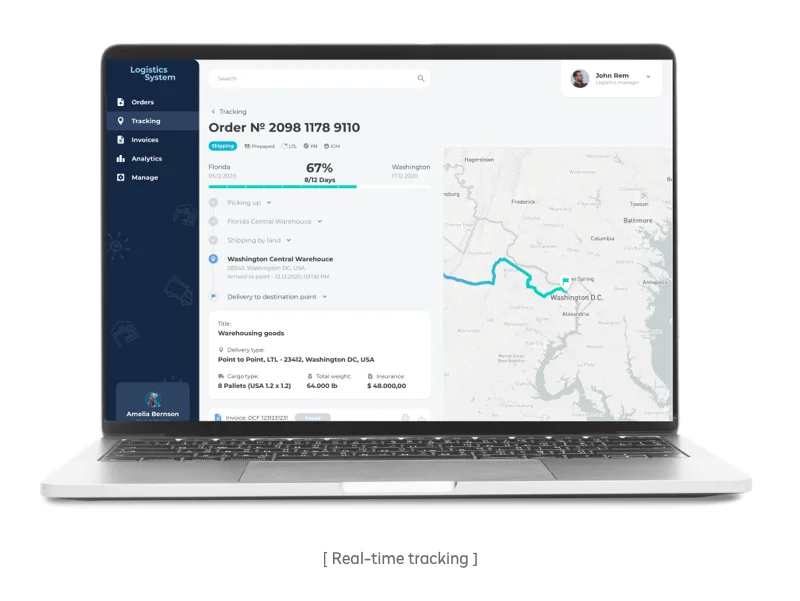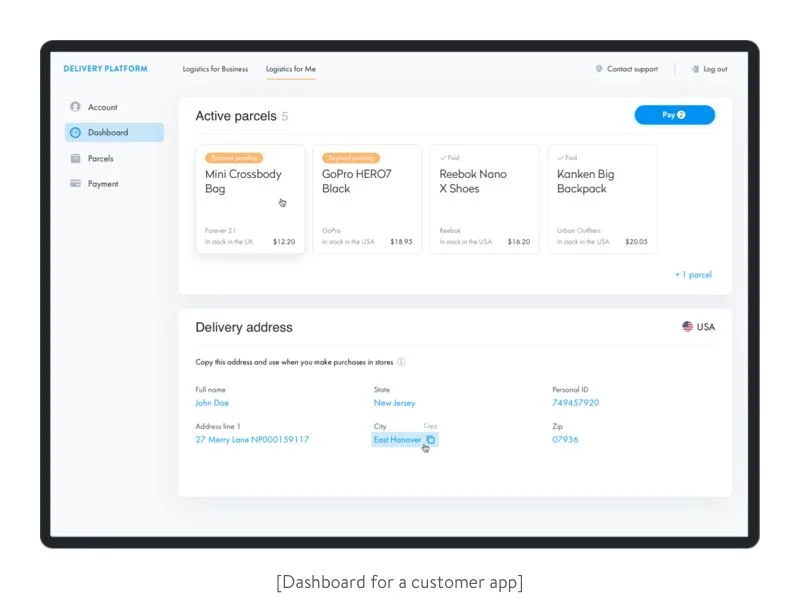
How a third-party logistics company can create a robust customer self-service portal
Providing an exceptional customer experience has become the main topic of discussion in most industries, including logistics. Third-party logistics providers strive to attract and retain customers by creating feature-rich customer portals.
Moreover, in 2020, B2B companies consider digital interactions two to three times more important to their customers than traditional interactions. The major spike in demand for transportation services has forced companies to automate and streamline their processes. Taking these facts into consideration, creating platforms where customers can track and order shipments at any time has become an unspoken rule in the transportation industry.
Some companies have already introduced client portals and are reaping the benefits of this decision. Some are still doubtful and remain behind their competitors.
If you’ve decided to create a self-service portal for your individual or business clients, it’s high time to take action. Creating a self-service portal will allow you to successfully compete with market leaders as well as get a competitive advantage over those who are still hesitating.
At Yalantis, we receive lots of inquiries from logistics companies looking to build customer portals. In this article, we walk you through the main benefits of creating this type of software and help you decide on requirements for your application. We hope this information will help you make a decision and develop a solution that will be warmly welcomed by your customers.


Why client portals are a boon for logistics companies
There are strong reasons behind the desire to build a customer portal as fast as possible. We’ve thoroughly analyzed the logistics market and the inquiries we’ve received to define some of the most common benefits of creating a customer portal:
- Reduced operational costs
Traditionally, to book a truckload shipment or check the status of a delivery process, a customer had to call a dedicated logistics manager or sales representative. By creating a self-service customer app, you enable your customers to check information or fill in order information by themselves, reducing the number of support requests.
Customer autonomy lets agents work more productively, focusing on more complex tasks and solving problems faster.
Also, self-service and automated order creation can save time for both your agents and customers as well as reduce errors in documentation. Hence, you can cut operating costs and eliminate the number of failed orders.
- Increased customer satisfaction
Customer portals empower users to access information or order services 24/7 without contacting a customer support representative. Within the last few years, self-service portals have become a necessity for organizations in many industries.
The logistics customer portal provides both business and individual customers with the ability to get precise and detailed information about their shipments at any time within a few taps as well as quickly book shipments and fill in information without needing to contact a logistics manager. With all the needed information in one place and dedicated customer service customer satisfaction with your company will increase exponentially.
A customer app will also help you increase customer satisfaction by gathering valuable insights on customer behavior. This data will help you improve the quality of your services and deliver a more personalized user experience.
- Increased customer lifetime value
Convenient services along with visibility of your processes can encourage customers to work with you on an ongoing basis. When you build transparent relationships with your customers and let them see all information and documents regarding their shipment orders in one place, they’ll want to keep using your app. Providing visibility and personalized offers is a great way to increase customer retention.
How to meet increasing customer expectations
To reap the benefits we’ve described above, your service should effectively meet specific customer needs. Here are the most wanted characteristics of an online logistics customer portal.
Bear in mind that in most companies, app for customers mirror information from internal software like transport management systems, order management software, and warehouse management systems. So as a rule, creating a customer portal is infeasible without automating a company’s internal processes (if you don’t have any software yet) or integrating existing software with new software solutions.
Read also: How to Use Technologies in Developing Logistics Management Systems
Visibility
The main motivation for customers to use your client portal is to get relevant and detailed information about their shipments at any time. Hence, creating transparent relationships with your clients should be your number one priority. Several features will help you achieve exceptional visibility.
- Real-time tracking
The ability to receive structured and relevant information at any time is the foundation of visibility and reliability. If a customer knows the exact position of all their shipments as well as their destinations and planned routes, they can adjust plans for future actions and instantly react to changing circumstances.
To provide only relevant data, enable a constant exchange of data between your software and your customer portal. Once the status of a shipment is changed in the transportation management system (TMS), it should immediately change in the customer portal too, ensuring the customer gets the real-time updates. Also, it’s important to provide estimates of delivery dates so your customers can plan their work.

You should also consider if unauthorized users can access information about shipments. Companies working with individual customers often allow unauthorized users to see the status of shipments using a unique tracking code. For the sake of security, however, most B2B logistics companies allow tracking only after authorization.
- Notifications on important events
Timely notifications on extraordinary situations allow your customers to quickly resolve issues or adjust to possible delays. Providing these notifications builds trust with your company. You should also notify customers that their orders are close or have been delivered.
For timely notifications, enable automatic SMS, email, or push notifications triggered by shipment statuses. In one of our other articles, we’ve shared technical details of implementing push notifications in a mobile app.
- Dashboards
Customers want to see all information about shipments at their fingertips — especially when a company has tens of shipments being delivered simultaneously. With multiple orders in progress, it’s time-consuming to track each item and build a distribution or manufacturing strategy based on shipment information.
To let customers easily monitor the status and manage all shipments, create a convenient dashboard with a simple user-friendly interface, easy navigation, and the ability to quickly see the details of a particular shipment.
Dashboards may consist of lots of data, so you shouldn’t overload this screen with too many elements. If you do, the interface will be cluttered and even make it harder to track shipments. Add only the most vital information and don’t create too many blocks.
Check out the dashboard design we made for one of our clients.

Robust self-service capabilities
Today, a considerable percentage of customers prefer using self-service portals rather than calling sales or support teams. Try to find the perfect balance between digital and human interactions. Automating routine tasks that can be done without your company’s logistics agents lets your employees focus on solving more complex problems.
- Creating orders online
Instead of telling all information about an order to your company’s logistics manager, customers can easily provide all the necessary information themselves. Your goal when enabling your users to create orders by themselves should be to make the process as easy and convenient as possible. Tons of unnecessary fields and the need to fill in the same information several times may frustrate customers. Offer several ways to speed up the process:
- Fill in general information while signing up and then automatically fill in this information when creating an order
- Use information from previous shipments
- Automatically load shipment information from files
- Let users create and edit order templates
Also, the number of fields may vary depending on the type of services or items being transported. So as not to overload the order form with lots of fields, make the system automatically add or hide fields based on user choices.
We’ve implemented this functionality for one of our clients by creating dropdown menus and checkboxes and changing the fields depending on user choices (i.e. special fields appear when a customer wants to transport items on pallets or in barrels). Check out how it looks:

When all the required information is filled in, the shipment inquiry is sent and processed by logistics managers, who calculate the cost of the shipment and assign orders to trucks. This also greatly eliminates the chance of mistakes due to misunderstandings.
This functionality also frees logistics managers from routine tasks so they can provide high-quality customer support faster and fully focus on customers’ problems and questions.
- Analytics and reporting
Analyzing a shipment is as vital as planning it, so you should provide your customers with useful insights on use of your services. This will help your clients plan future shipments and provide them with useful metrics for tracking and measuring their business performance.
For instance, analytics on the Panalpina platform (which is now part of DSV) shows the total weight, number of shipments, and shipment time. You can also provide analytics on total money spent, the percentage of successful orders, and other metrics.
Read also: Real-time Big Data Processing
- Automatic document generation
A lot of business operations rely heavily on paper documentation. Logistics, bills of lading, delivery receipts, commercial invoices, and claims forms are common documents needed. Enabling constant access to them in the customer portals builds transparent relationships between customers and vendors.
Documents can be generated automatically in your internal software such as a TMS, order management system, delivery management system, or CRM tool. These documents can then easily be accessed by customers on the customer portal. You can also allow your customers to upload their own document templates and generate custom documents. This will help them with internal documentation maintenance and reporting.
Data protection
Your customer portal gathers and stores sensitive user information such as operational, payment, and employee data. To secure data transferred between your internal software and customer portal, use the best practices:
- Use the OWASP Risk Rating methodology to find vulnerabilities in your system and estimate the gravity of cybersecurity risks.
- Secure your web application with HTTPS.
- Choose a secure and reliable database management system to mitigate the risk of data breaches.
- Create a strict hierarchy of user types, access levels to prevent unauthorized users from accessing sensitive information.
- Protect APIs for exchanging data between software. In this article, you can read about how to create and secure RESTful APIs.
Remember that every component of your system should be protected from data breaches. In addition, it’s vital to educate personnel on cybersecurity procedures. The best practice is to prevent employees from downloading unauthorized software and apps, opening suspicious emails, and using software improperly. These actions could potentially breach your security.
What can help you create software aligned with your business?
To build a customer portal, some companies mistakenly follow the strategy of creating customer applications identical to the apps of their rivals. Unfortunately, this strategy has a high risk of failure, since it doesn’t take into consideration the specificity of a company’s business processes and customers’ needs.
To build an application that meets the needs of your customers and is perfectly aligned with your business processes, you should conduct thorough analysis of your business processes and existing software solutions. Here are some questions you should ask yourself to define the requirements for your customer portal:
1. What are the most common questions customers ask your logistics agents?
Survey your employees on the most common questions and problems your customers bring to the support team. This will help you define the top priorities for your customer portal. Do employees have problems accessing invoices or bills of lading? Then creating a convenient document database should be a high priority.
2. Is it convenient for your employees to use your existing software?
Interview your employees about the convenience of using existing software. What functionality do existing solutions cover and what tasks should your logistics managers do manually?
Create a list of problems your employees encounter when using the software. Analyze the potential causes of mistakes and data losses. Also, define what processes could be automated.
3. How is information stored and processed?
Before your customers can access the information they need in the customer portal, ensure that information is effectively stored and processed on your TMS or ERP software. How do agents collect and change information about shipments? What software do they use for these purposes? Are there any risks of a data breach? How do your employees gather information for reports and exchange data between operating units? Answer these questions to find possible room for improvements for storing and exchanging data.
4. How can customers access shipment information?
Do your agents send shipment information manually via email or is it sent automatically? How do they notify your customers about delays or arrivals? Define the most favorable communication channels and the format in which information will be sent to users. Also, pay close attention to integration with your existing software so information is immediately changed and sent to the customer portal via a safe communication channel.
As you can see, building a successful customer portal is impossible without internal software (like a TMS, WMS, or ERP) that works like a clock. If you want to create a custom client portal that integrates with third-party solutions or create both a TMS and customer portal, you can rely on us. Yalantis has solid experience creating logistics software even under tight deadlines as well as integrating custom software with existing solutions.
You can learn more about what we can do for logistics companies or contact us directly to discuss a solution tailored to your particular needs.
Want to automate you logistics processes?
Discover how we can help you
Rate this article
5/5.0
based on 1,133 reviews



